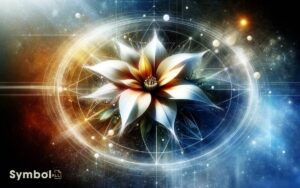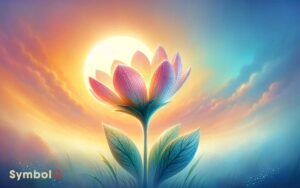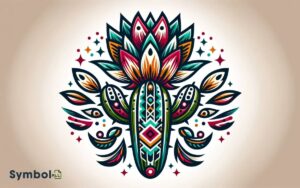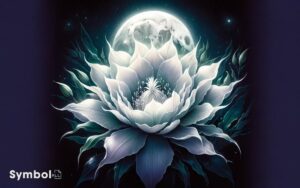Chinese New Year Flower Symbolism: Orchids!
In Chinese New Year, flowers aren’t just decorations; they’re symbols rich with meaning, embodying hopes and wishes for the year ahead. Orchids reflect fertility and refinement, promoting perfection in your life.
Chrysanthemums, with their longevity, encourage rejuvenation, while peonies signal wealth and honor, ensuring prosperity. Plum blossoms herald resilience, marking a triumphant end to winter with their strength.
Each bloom carries a story of aspirations, from bamboos strength and continuous growth to lotus flowers purity and spiritual awakening.
These floral emblems offer a glimpse into a culture that values harmony, prosperity, and renewal. Exploring each flower’s significance reveals a deeper understanding of this vibrant celebration.
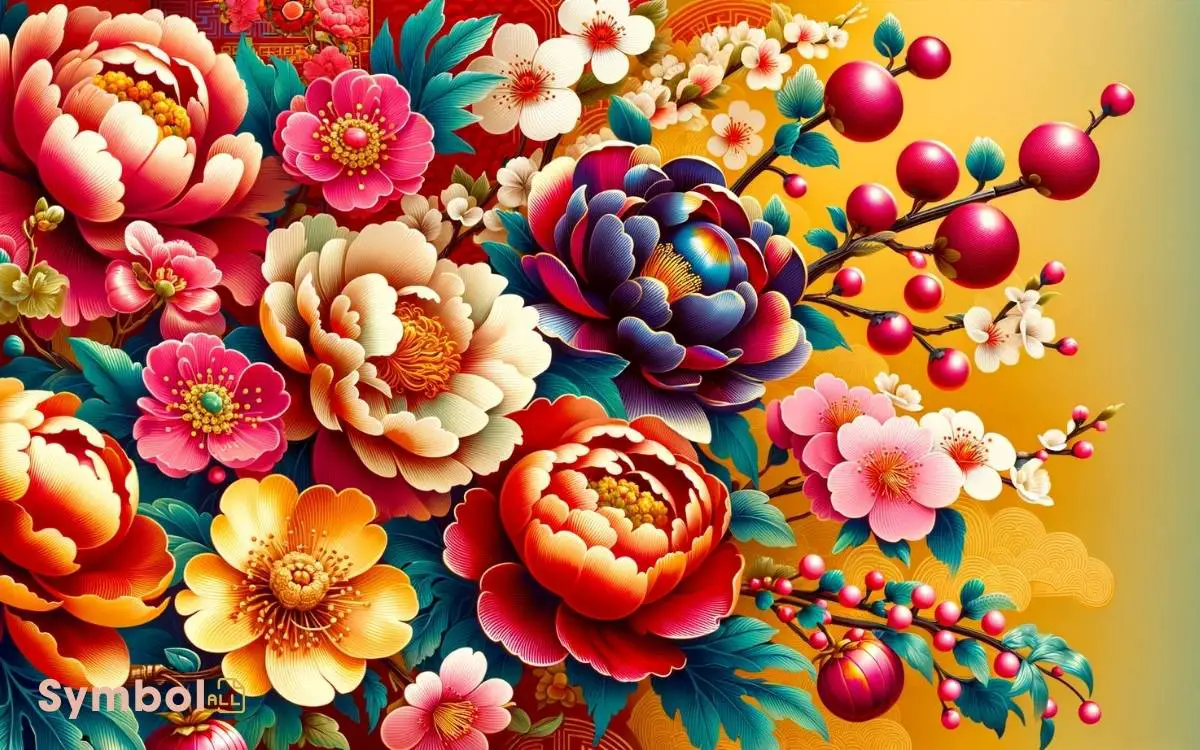
Key Takeaways
The Significance of Flowers
In the world of Chinese New Year celebrations, flowers aren’t merely decorative elements; they carry profound symbolic meanings that reflect hopes, aspirations, and blessings for the forthcoming year.
Each blossom selected for display during this auspicious time serves as a visual invocation of specific desires and intentions.
For instance, orchids, esteemed for their delicate beauty, are emblematic of fertility, abundance, and refinement, conveying wishes for a prosperous and cultured life.
Similarly, the bright and cheerful chrysanthemum is often associated with longevity and rejuvenation, a hopeful prayer for health and well-being.
These floral symbols are deeply ingrained in the cultural tapestry, offering insights into the values and aspirations that have shaped generations.
Through understanding these significances, you’re invited into a rich tradition that celebrates the cyclical renewal of life with beauty and intention.
Peonies: Wealth and Honor
Amid the vibrant tapestry of Chinese New Year celebrations, peonies stand out as a symbol of wealth and honor, reflecting centuries-old values that continue to resonate deeply within the culture.
These flowers, often depicted in art and literature, embody prosperity and success, making them a favored choice during the festivities.
Their lush, full petals are seen as indicative of a rich and honorable life, offering a visual homage to the aspirations and achievements of the family.
Cultivating or displaying peonies during the New Year is believed to invite these qualities into one’s home, creating an environment ripe with potential for growth and recognition.
Consequently, peonies hold a cherished place in the heart of the celebration, weaving together the threads of tradition and aspiration.
Orchids: Fertility and Refinement
Orchids, revered for their delicate beauty, symbolize fertility and refinement within the context of Chinese New Year celebrations.
These blooms aren’t just visually stunning; they carry deep meanings, anchoring themselves in the traditions and values celebrated during this auspicious time.
When you incorporate orchids into your festivities, you’re embracing symbols of not only fertility, suggesting the blossoming of new beginnings, but also of refinement, reflecting a purity and elegance in character.
| Aspect | Significance |
|---|---|
| Color | Varied, each conveying a unique message |
| Shape | Graceful, embodying perfection and balance |
| Arrangement | Carefully considered for harmony |
| Placement | Central in decorations for visibility |
| Cultural Role | Essential in symbolizing noble virtues |
Incorporating orchids into your New Year’s decor isn’t just about beauty; it’s a thoughtful nod to fertility, family growth, and the refined elegance of life’s journey.
Chrysanthemums: Longevity and Rejuvenation
As you explore the significance of chrysanthemums during Chinese New Year, you’ll find they’re not just flowers, but symbols steeped in meaning.
They represent longevity and rejuvenation, echoing the desires for a prosperous and healthy year ahead.
Understanding their symbolic meanings, alongside the cultural practices and beliefs surrounding them, offers a deeper appreciation of their role in festivities.
Symbolic Meanings Explained
In the rich tapestry of Chinese New Year traditions, chrysanthemums hold a revered position, symbolizing longevity and rejuvenation due to their robust nature and ability to bloom into the autumn months.
This symbolism isn’t arbitrary; it’s deeply rooted in the flower’s unique characteristics and historical significance.
Chrysanthemums, often seen flourishing when most other flowers succumb to the chill, represent not just essential vitality but also the ability to thrive in adversity. Their longevity is a metaphor for a life well-lived, full of vibrancy and resilience.
The aspect of rejuvenation is tied to the flower’s perennial cycle, reminding us of renewal and the promise of new beginnings.
For you, embracing the chrysanthemum’s symbolism during Chinese New Year encourages reflection on enduring values and the continuous pursuit of revitalization in one’s life journey.
Cultural Practices and Beliefs
Why do chrysanthemums occupy such a central role in Chinese New Year celebrations and cultural practices, symbolizing longevity and rejuvenation? It’s rooted in ancient Chinese philosophy and the enduring belief in the flower’s power to promote life’s vitality.
Chrysanthemums, with their full, vibrant blooms, represent not just physical longevity but the rejuvenation of the spirit and the wish for a life filled with joy and health. This symbolism is deeply embedded in cultural rituals and artistic expressions around the New Year.
Displaying these flowers in homes and public spaces is believed to usher in a new year brimming with endless possibilities and to renew the bonds of family and community. They’re a visual confirmation to the enduring human desire for renewal and growth.
Plum Blossoms: Resilience and Renewal
As you explore the symbolism of plum blossoms in the context of Chinese New Year, you’ll find they stand as a potent symbol of winter’s end and the ushering in of spring.
These blossoms are revered as an emblem of hope, illustrating the strength and resilience required to withstand adversity.
Moreover, their cultural and historical roots enrich their significance, intertwining with centuries of literary and artistic expressions in China.
Symbolizing Winters End
Plum blossoms stand as a resilient symbol of renewal, marking the end of winter with their vibrant bloom. As winter’s chill loosens its grip, these flowers emerge, braving the still-cold air to herald the coming of spring.
They don’t simply signify the shift of seasons; they embody the strength and perseverance needed to overcome adversity.
The plum tree’s ability to flower amidst the snow speaks volumes about endurance and the promise of rejuvenation. In Chinese culture, they’re not just seen as a natural phenomenon but as a deeply ingrained emblem of fortitude.
Observing their bloom, you’re reminded that even in the coldest moments, life finds a way to assert itself, promising warmth and growth ahead.
Emblem of Hope
Beyond their resilience, plum blossoms serve as a poignant emblem of hope, illuminating paths with the promise of renewal and brighter days ahead. As you explore further into their symbolism, you’ll find these flowers embody strength in adversity.
Their early bloom, often against the chill of late winter, signifies an unwavering spirit and the inevitability of spring’s warm embrace.
This stark contrast between the fragile beauty of the blossoms and the harsh conditions in which they thrive offers a powerful metaphor for human endurance and optimism.
In the context of Chinese New Year, plum blossoms remind us that patience and steadfastness can lead to rejuvenation and prosperity. They encourage you to look forward with anticipation, embracing the cycles of nature as a source of inspiration and hope.
Cultural and Historical Roots
Delving into the cultural and historical roots of plum blossoms reveals their deep-seated significance in symbolizing resilience and renewal throughout Chinese history.
- Ancient Poetics: Plum blossoms have been celebrated in Chinese poetry and literature for centuries, embodying the spirit of perseverance amid adversity.
- Lunar New Year: They’re a quintessential symbol during the Lunar New Year, representing hope and the promise of spring.
- Imperial Symbolism: Historically, plum blossoms were revered by emperors and scholars alike, symbolizing integrity and the renewal of life.
- Artistic Depictions: In traditional Chinese art, plum blossoms are often depicted alongside bamboo and pine, representing the ‘Three Friends of Winter.’
- Philosophical Significance: Their early bloom, even in the chill of winter, serves as a metaphor for maintaining virtue in tough times, embodying the Confucian ideal of moral beauty and strength.
Narcissus: Good Fortune and Prosperity
Among the myriad of flowers symbolizing new beginnings and fortune in Chinese New Year celebrations, the narcissus stands out for its emblematic representation of good fortune and prosperity.
This flower, with its delicate white blossoms, not only embodies purity and elegance but also heralds the coming of wealth and success.
In Chinese culture, the blooming of a narcissus during the New Year is believed to bring an increase in fortunes and a prosperous year ahead. Cultivating this plant has become a cherished tradition, with many families nurturing it to bloom precisely at the festival.
The practice isn’t merely horticultural; it’s steeped in the hope that the coming year will be filled with blessings and abundance, making the narcissus a revered symbol in the festivities.
Bamboo: Strength and Growth
Turning your attention to bamboo, you’ll find it imbued with a rich symbolism of strength and continuous growth, deeply rooted in cultural traditions.
Its resilience isn’t only a confirmation of physical endurance but also represents the ability to overcome adversity.
The significance of bamboo in cultural narratives highlights its role in fostering personal and communal development, a theme revered during the Chinese New Year.
Bamboo Resilience Meanings
In Chinese culture, bamboo symbolizes resilience and growth, embodying the qualities of strength, flexibility, and endurance that are highly valued. This symbolism is deeply woven into the fabric of traditions and celebrations, particularly during the Chinese New Year.
When you incorporate bamboo into your festivities, you’re embracing:
- Strength: Bamboo’s ability to withstand harsh conditions.
- Flexibility: Its capacity to bend without breaking.
- Endurance: Bamboo’s perseverance through the seasons.
- Harmony: The peace and balance it brings to any setting.
- Renewal: Symbolizing fresh starts and new beginnings.
Cultural Growth Significance
Bamboo’s symbolism extends beyond its physical resilience, embodying growth and cultural significance that enriches Chinese traditions and personal growth narratives.
You’ll find bamboo deeply interwoven in the fabric of Chinese culture, symbolizing unwavering strength and rapid growth. This plant teaches you the importance of being flexible and strong amidst life’s uncertainties, mirroring the bamboo’s ability to bend without breaking.
In the context of the Chinese New Year, bamboo represents the hope for a year of growth, stability, and prosperity. It serves as a reminder that, like bamboo, you can thrive and flourish even in challenging conditions.
Its enduring nature encourages you to pursue your goals with steadfast determination, embodying the essence of perseverance and resilience that are celebrated during this auspicious time.
Pussy Willow: Growth and Prosperity
Pussy Willow, symbolizing growth and prosperity, is a revered plant in Chinese New Year celebrations, embodying the hope for a flourishing year ahead. This plant’s significance is deeply embedded in tradition, with each bud representing new life and opportunities.
When you include Pussy Willow in your festive decor, you’re embracing:
- Renewal: Each bud signifies the renewal of life.
- Prosperity: Believed to bring wealth and abundance.
- Growth: Symbolizes personal and professional growth.
- Resilience: Reflects the ability to thrive in adversity.
- Hope: A reminder of the endless possibilities the new year brings.
Incorporating Pussy Willow into your celebrations not only enhances the aesthetic but also imbues your space with deep cultural meaning, encouraging an atmosphere of positivity and growth.
Lotus: Purity and Enlightenment
Embodying purity and spiritual enlightenment, the Lotus flower stands as a revered symbol in Chinese New Year celebrations, inviting you to reflect on new beginnings and the journey towards inner wisdom. Embracing both beauty and resilience, the Lotus flower’s ability to bloom in muddy waters mirrors the human capacity to rise above challenges and embrace growth. During Chinese New Year, its presence serves as a gentle reminder to cultivate harmony within ourselves and our loved ones. Many even immortalize its significance through symbolic flower tattoos for family, creating a lasting representation of unity, transformation, and hope.
This exquisite bloom, emerging unscathed from murky waters, represents an individual’s ability to rise above adversities, maintaining integrity and achieving a state of moral purity.
In the context of the festival, incorporating the Lotus in decorations or gifts conveys wishes for the recipient’s spiritual awakening and guidance towards enlightenment. Its significance is deeply rooted in Chinese culture, symbolizing not just physical, but moral and spiritual cleanliness.
The Lotus encourages you to persevere, reminding you that from the darkest waters, the most beautiful flowers bloom, embodying hope and the possibility of untainted beauty and wisdom in life’s journey.
Peach Blossoms: Romance and Prosperity
Shifting our attention to peach blossoms, you’ll discover that these flowers aren’t just a delight for the eyes; they carry profound symbolic significance in Chinese culture, especially during the New Year.
They’re thought to attract love energy, making them a desired decoration for those in pursuit of romance.
Additionally, their connection with wealth expansion and the strategic placement recommended by Feng Shui principles emphasize their significance in ushering prosperity and harmony into one’s life.
Attracting Love Energy
To attract love energy into your life, consider the powerful symbolism of peach blossoms, which are revered for their associations with romance and prosperity.
These delicate flowers embody the essence of attraction and affection, making them a pivotal symbol during the Chinese New Year for those seeking love.
Integrating peach blossoms into your surroundings can subtly influence the flow of love energy:
- Place peach blossom branches in a vase in your living area to invite romantic opportunities.
- Wear peach blossom motifs to enhance your personal charm.
- Gift peach blossoms to signal your interest in cultivating a romantic relationship.
- Incorporate peach blossom designs in your home décor for a constant flow of love energy.
- Meditate near peach blossoms to focus your intentions on attracting love.
Symbolizing Wealth Growth
Beyond their enchanting allure in matters of the heart, peach blossoms also symbolize the flourishing of wealth, offering a dual promise of prosperity and romance.
When you integrate these blooms into your celebrations, you’re not just enhancing the ambience with their beauty; you’re invoking an ancient belief in their power to attract financial success.
It’s a practice steeped in tradition, where the delicate petals represent both the softness of love and the strength of a growing fortune.
| Aspect | Significance | Impact on Wealth |
|---|---|---|
| Color | Vibrant Pink | Invigorates financial energy |
| Bloom Season | Spring | Symbolizes new beginnings in wealth |
| Petal Number | Five | Represents elements bringing balance |
| Placement | Central Living Areas | Enhances wealth energy flow |
| Tradition | Lunar New Year | Strengthens prosperity bonds |
Blossom Feng Shui Tips
Harnessing the ancient art of Feng Shui, you can strategically place peach blossoms in your home to enhance both your love life and financial prosperity.
To effectively utilize these blooms, consider the following tips:
- Place peach blossoms in the southeast corner of your home to attract wealth.
- For enhancing romantic opportunities, position them in the southwest.
- Make sure the blossoms are fresh; wilted flowers can attract negative energy.
- Opt for a pair of peach blossom branches to symbolize partnership in love.
- Refresh the water daily and remove any fading flowers to maintain positive energy flow.
Azaleas: Family Harmony and Happiness
Symbolizing family harmony and happiness, azaleas bloom with the promise of fostering stronger bonds and joy within households during the Chinese New Year.
These vibrant flowers are deeply embedded in cultural traditions, representing the aspiration for peaceful relationships among family members. In Chinese culture, the azalea isn’t merely a plant of aesthetic value; it embodies a profound wish for unity and felicity.
Integrating azaleas into New Year’s decor isn’t just about enhancing the home’s beauty it’s a deliberate act to invite positive energy and reinforce familial ties.
Their presence is a subtle, yet powerful, reminder of the importance of harmony, making them a cherished symbol in festivities that honor the values of togetherness and mutual respect.
Camellia: Admiration and Perfection
Camellias, embodying both admiration and the quest for perfection, hold a revered place in Chinese New Year celebrations as symbols of distinction and unblemished beauty. These blooms, with their layered petals and rich hues, convey deep respect and high esteem.
When you gift camellias during this festive season, you’re not only presenting flowers; you’re offering a wish for excellence and success.
- Respect: Camellias signify deep admiration for someone’s achievements and qualities.
- Perfection: Their flawless beauty symbolizes the aspiration for perfection in one’s endeavors.
- Distinction: Gifting camellias expresses recognition of someone’s unique talents and contributions.
- Success: They’re a traditional symbol of good fortune and prosperity, essential elements in Chinese New Year celebrations.
- Beauty: The aesthetic appeal of camellias enhances the festive ambiance, embodying the celebration’s spirit of renewal and hope.
Water Lily: Peace and Tranquility
Water lilies, revered for their serene beauty, offer a symbol of peace and tranquility in the midst of Chinese New Year celebrations. These aquatic plants, floating effortlessly on water, represent an anchor of calmness in turbulent times.
Their blossoming amidst still waters serves as a reminder to maintain composure and seek inner peace, mirroring the values cherished during this festive period.
| Symbolic Aspect | Significance |
|---|---|
| Serenity | Encourages calmness and peace |
| Effortless Floating | Symbolizes grace under pressure |
| Blossoming in Water | Represents purity and renewal |
Embracing the symbolism of water lilies, you’re invited to reflect on the importance of peace and tranquility, offering a moment of calm reflection amidst the joyous chaos of the New Year.
Magnolia: Nobility and Dignity
Amidst the vibrant celebrations of Chinese New Year, the magnolia stands tall as a beacon of nobility and dignity. This esteemed flower symbolizes more than just aesthetic beauty; it embodies profound cultural values and virtues that have been revered for centuries.
By incorporating the magnolia into your New Year’s decor, you’re not just adding natural elegance you’re invoking a rich tapestry of symbolism.
- Resilience: Magnolias bloom brilliantly even in harsh climates, representing unwavering strength.
- Purity: Their pristine white petals signify purity of spirit and heart.
- Perseverance: Magnolias’ ability to bloom year after year symbolizes endurance and persistence.
- Renewal: With their springtime blossoming, they herald new beginnings and hope.
- Grace: The magnolia’s dignified presence evokes a sense of sophistication and grace.
Understanding these symbols enriches your appreciation of the magnolia’s role in celebrating Chinese New Year.
Citrus Trees: Wealth and Abundance
Why not welcome prosperity into your home during Chinese New Year by embracing the traditional symbol of citrus trees, revered for signifying wealth and abundance?
These verdant trees, often laden with ripe, golden fruits, aren’t merely decorative. They embody the ancient Chinese belief in the power of nature to influence fortune.
The round shape and vibrant color of the citrus fruits symbolize gold and wealth, making these trees highly sought after during the festivities.
It’s a practice deeply rooted in history, where displaying citrus trees in your home or gifting them to loved ones is considered a gesture of wishing prosperity upon them.
This custom not only enriches the cultural tapestry of the celebration but also serves as a reminder of nature’s role in bringing abundance into our lives.
Conclusion
As you’ve journeyed through the garden of Chinese New Year’s floral wisdom, each blossom has whispered ancient secrets of prosperity, resilience, and nobility.
Like a tapestry woven from vibrant threads of tradition, these flowers not only adorn celebrations but also impart deep cultural significance.
May the petals of peonies, orchids, and all their companions guide you towards a path of wealth, honor, and tranquility, illuminating your festivities with their timeless elegance and profound symbolism.

